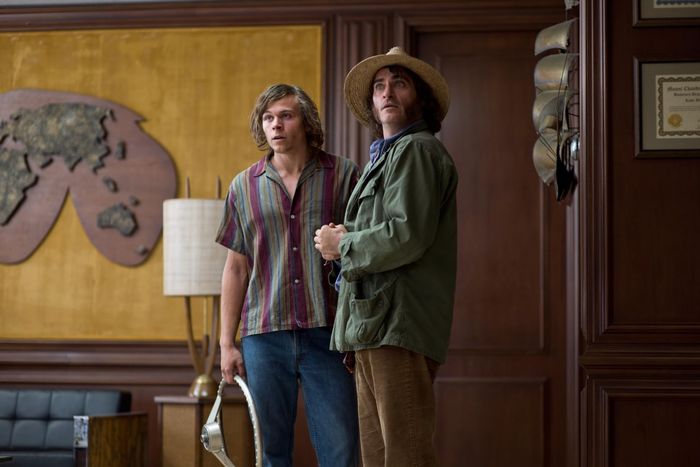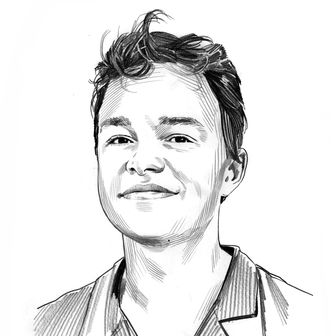
Every Wednesday in August, Vulture will choose a film to watch with readers as part of our Vulture Movie Club. This week’s selection comes from Vulture copy editor Christopher Stanton, who will begin his screening of Inherent Vice on Wednesday, August 28, at 7 p.m. ET. Head to Vulture’s Twitter to catch the live commentary.
By the mid-’70s, Neil Young was already writing music laced with the nostalgia of a much older man. “Back in the old folky days,” he sings at the start of “Ambulance Blues,” the mournful nine-minute closer to 1974’s On the Beach, “the air was magic when we played.” Never mind that Young was 28 when the album came out, or that the “old folky days” couldn’t have been much more than five years earlier. Something had shifted for him — personally, politically — and he didn’t need to wait for the wisdom that age supposedly brings to know that it was never coming back. In fact, maybe he was even misremembering it all to begin with, yearning for a past that never happened. (Things get a little hazy when you’re doing honey slides, the pan-fried honey-and-weed concoction that fueled the album’s recording sessions.) After the stratospheric, isolating success of 1972’s comparatively upbeat Harvest, Young says he “headed for the ditch,” and On the Beach represents the pinnacle of his so-called “Ditch trilogy”: a post–Manson murders freakout of an album about loneliness and the corporate death of the hippie dream. While borne, in part, out of the Canadian singer’s personal crises, the album maps neatly onto the period of American history it emerged into, arriving amid the lingering cultural hangover from the ’60s and less than a month before a certain paranoid, hippie-hating president resigned the office in disgrace. (In one of many instances of Young needling Nixon, the newspaper headline on the album’s cover reads, “Sen. Buckley Calls for Nixon to Resign.”) Something had shifted, and it was never coming back.
Released 40 years after On the Beach, Paul Thomas Anderson’s 2014 neo-noir, Inherent Vice — adapted from the Thomas Pynchon novel — wrestles with many of the same anxieties. Set in 1970 in the fictional South Bay-adjacent town of Gordita Beach, California, the movie follows Doc Sportello (Joaquin Phoenix), a stoner private investigator who receives a visit from his elusive ex, Shasta Fay Hepworth (Katherine Waterston). “I need your help, Doc,” she says, before explaining that the married man she’s sleeping with, a wealthy real-estate developer named Mickey Wolfmann (Eric Roberts), is in danger. His wife and his wife’s lover have a “creepy little scheme” to commit Wolfmann to some kind of asylum, and Shasta’s torn about whether or not to go along with it. Doc agrees to look into it, and his subsequent investigation leads him to the Golden Fang, an impossibly vast, vertically integrated drug syndicate that employs everyone from perverted dentists (hi, Martin Short) to members of the Aryan Brotherhood. As Doc stumbles, stoned, from one confounding clue to the next, his investigation becomes an excuse to dwell on his failed relationship with Shasta, and a means of peeling back the layers of ’60s hippie culture only to find that it was compromised from the beginning. In its depiction of Doc being pulled relentlessly toward the past, Inherent Vice offers up — among other things — perhaps the definitive cinematic interpretation of Young’s music.
Some aspects of that are immediately apparent: Young was an obvious stylistic inspiration for costume designer Mark Bridges’s conception of the Doc character, and the movie’s soundtrack features not one, but two different Neil songs. On a thematic level, though, Inherent Vice also fixates on the same cultural fulcrum point as much of Young’s mid-’70s output, taking place in the immediate wake of the Manson murders, when every hitch-hiking hippie suddenly seemed menacing to middle America. In both the film and Pynchon’s novel, battle lines are drawn early. “Gentleman of the straight-world persuasion?” Doc asks derisively when he first learns of Shasta’s new lover. Doc’s love-hate relationship with the cop Bigfoot Bjornsen (Josh Brolin, in his frozen-banana-sucking prime) further underscores that divide, with Bigfoot frequently bemoaning “hippie scum” while Doc snarks back about how cops spend their time entrapping innocent hippies.
Even as they pour one out for the old folky days, both Young’s music and Inherent Vice contend they were never quite what they appeared to be. Wary of the corporate sheen that quickly commodified the spirit of the ’60s, Young refused to be filmed performing at Woodstock and lyrically thrashed his Crosby, Stills, Nash & Young bandmates for growing complacent in their success — playing the part of hippie musicians for an industry all too eager to milk that image for whatever it was worth. Doc, meanwhile, makes a painful discovery: Through its COINTELPRO program, the FBI has turned countless hippies into informants and used their adjacency to politically radical groups to gather intel. While watching TV with his district-attorney lover, Penny Kimball (Reese Witherspoon), Doc spirals into a fit of stoned paranoia after seeing his supposedly dead hippie acquaintance Coy Harlingen (Owen Wilson) get arrested on a news broadcast while protesting a Nixon speech. Now that he’s been on TV, Penny explains, “police can infiltrate him into any group they want to.”
By 1970, in other words, things had gotten dark, and Inherent Vice sometimes adopts the hopeless perspective of a Nixon-era paranoid thriller like The Parallax View. That bleakness, however, is balanced out with a desperate romanticism, and in its softer moments, Inherent Vice takes a page from Young’s songbook, finding warmth in a hazily remembered past. For the movie’s two Neil selections, Anderson elides any slowcore dirges from On the Beach and instead opts for “Harvest” and an archival take of “Journey Through the Past” — two yearning acoustic jams in the vein of the singer’s biggest hits. And here’s where Inherent Vice’s relationship to Young’s music becomes a bit harder to define: More than any other film I’ve seen, it channels the slippery, seductive pull of the singer’s acoustic ballads, drawing you back to it time and again in hopeless attempts to pin down whatever inscrutable tangle of emotions it drags out.
Both of the film’s Neil songs soundtrack moments when Doc indulges the fog of nostalgia, allowing it to distort his memories of his time with Shasta. The “Journey Through the Past” sequence, in particular, aches with romance in a way that makes you want to live in it forever even as the film reminds you it can’t last. (“It was late in their time together,” Sortilège says in a ghostly voice-over as Doc and Shasta run through the rain, “when she was already halfway out the door.”) Just as Neil sings of an elusive past, Inherent Vice dangles a rush of emotions in front of you only to slip away the second you try to grasp them.
Much like reading Pynchon, viewing Inherent Vice for the first time is an overwhelming, confounding experience — not least because its plot is intentionally convoluted, drawing Doc perpetually deeper into its many rabbit holes, from the racist history of L.A. land use to the intricacies of maritime insurance. The film leaves you to find your own way into its particular slipstream, whether through its Naked Gun–esque humor or the affecting nature of Young’s voice. As Kim Morgan argues, in what might be the best piece of writing on the movie, “It doesn’t so much require multiple viewings, it seduces you to revisit it, again and again, pulling you in far enough, while remaining just enough out of reach. You feel as if you need it.” Both Young’s music and Inherent Vice contend that there are some things you can’t avoid losing — precious, uninsurable cargo that leaves you behind with nothing but hazily recalled memories. Maybe the only way to access the “old folky days” now is through another spin of “Harvest” or another viewing of Inherent Vice.
More From Vulture Movie Club
- The Action-Goth Masterpiece That Never Got Its Due
- Without Brandon Lee, The Crow Doesn’t Fly
- Signs Is the M. Night Shyamalan Experience at Its Best


